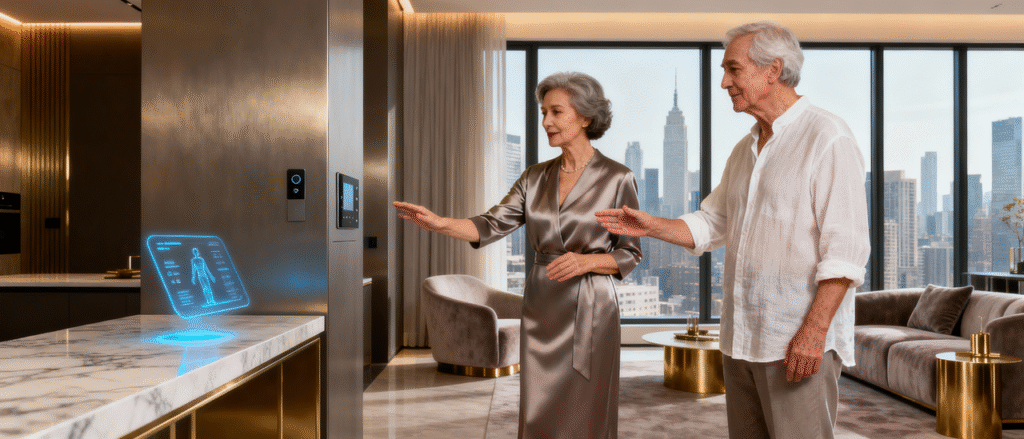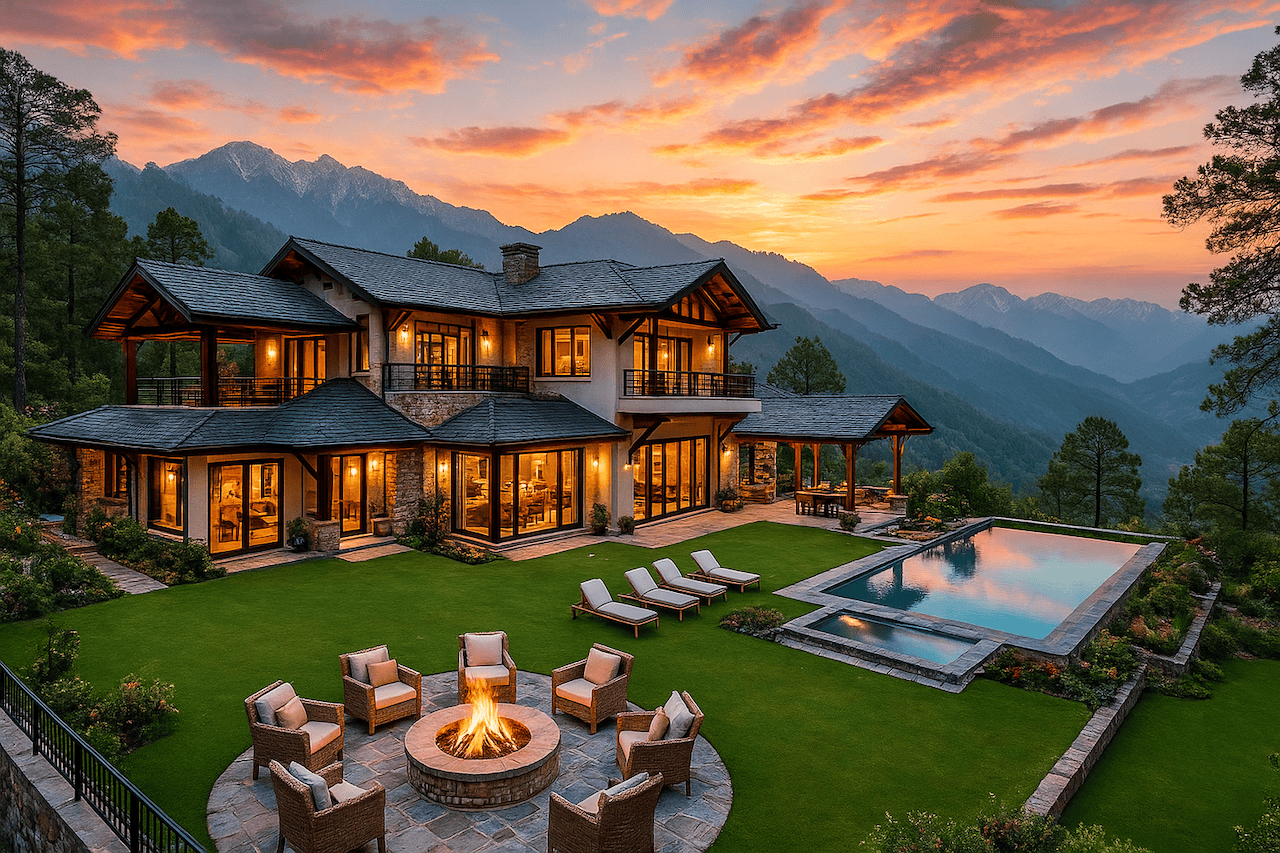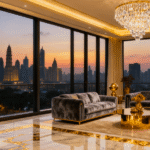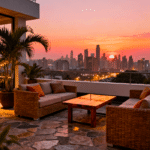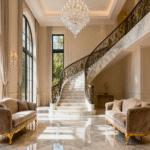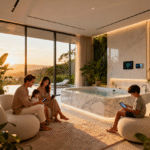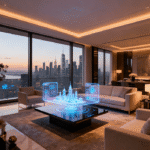Now Reading: Smart Luxury Homes: How AI and IoT Are Redefining UHNI Residences in the Global Property Renaissance
- 01
Smart Luxury Homes: How AI and IoT Are Redefining UHNI Residences in the Global Property Renaissance
Smart Luxury Homes: How AI and IoT Are Redefining UHNI Residences in the Global Property Renaissance
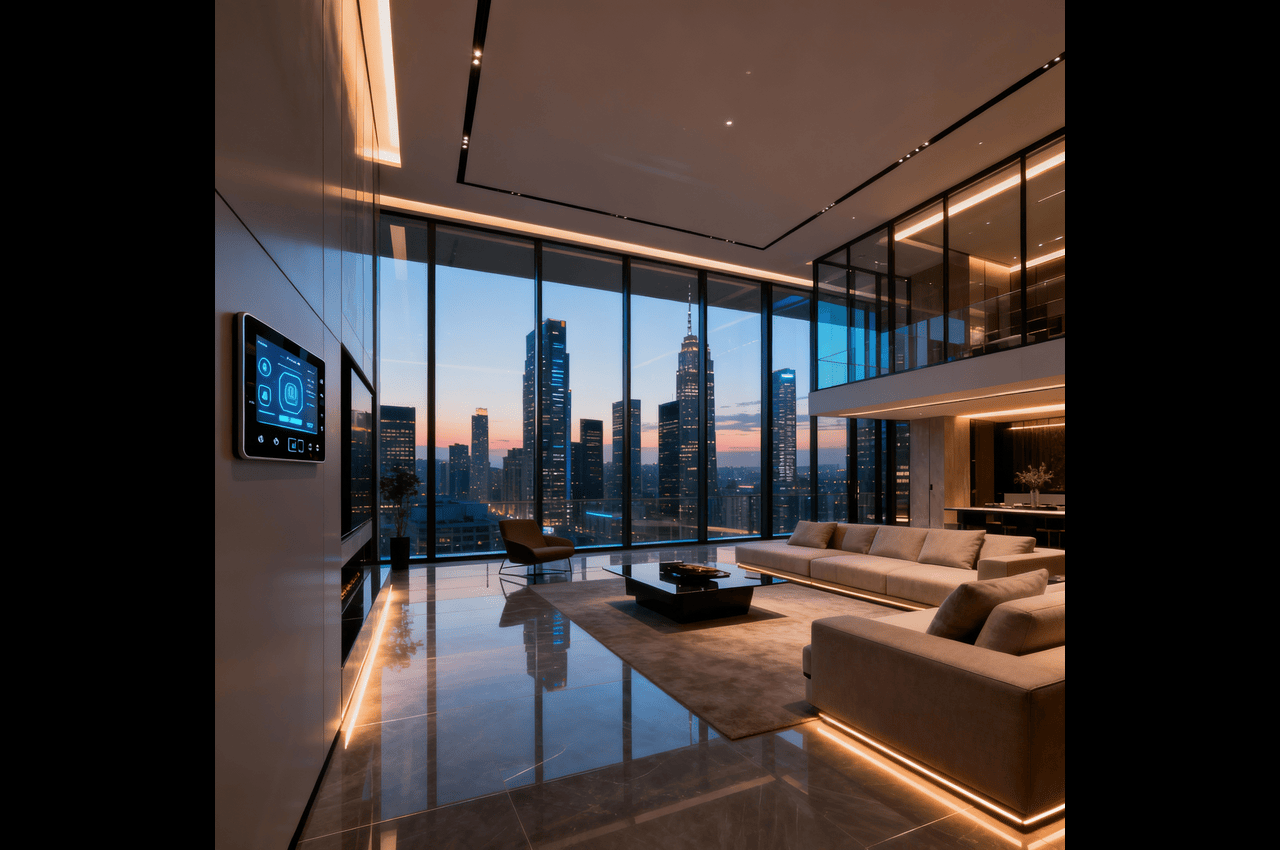
The convergence of artificial intelligence, Internet of Things (IoT), and luxury real estate is orchestrating a seismic shift in how Ultra-High-Net-Worth Individuals (UHNIs) conceptualize, acquire, and inhabit their primary residences. This transformation extends far beyond aesthetic opulence, fundamentally redefining property investment as a strategic asset class that harmonizes cutting-edge technology with generational wealth preservation.
Global smart home market valuations are projected to surge from $147.5 billion in 2024 to $537.3 billion by 2030, representing a compelling 27% compound annual growth rate. Simultaneously, AI integration in real estate is experiencing exponential expansion, with market size anticipated to reach $1.8 trillion by 2030, driven by a remarkable 35% CAGR. For discerning UHNIs, these trends signal unprecedented opportunities to leverage smart luxury homes as both lifestyle sanctuaries and high-performing investment vehicles.
India’s UHNI population, currently standing at 14,500 individuals, is forecasted to expand by 50% to reach 24,800 by 2028. This demographic surge is catalyzing luxury residential sales from 19,700 units in 2024 to a projected 94,500 units by 2030, with smart-integrated properties commanding premium valuations 15-40% above traditional luxury residences.
Market Shift: The New Paradigm of Intelligent Luxury
The luxury real estate landscape is experiencing what industry leaders describe as its most significant transformation since the post-war economic boom. Unlike previous cycles driven primarily by location and architectural grandeur, today’s market revolution centers on technological sophistication and experiential intelligence.
Global Context: East Meets West in Innovation
North American Leadership: The United States and Canada continue to dominate global UHNI populations with 272,000 ultra-wealthy individuals, achieving 45% smart home adoption rates and maintaining the highest AI/IoT integration scores at 85 points[regional analysis]. Silicon Valley’s tech elite are pioneering residential AI ecosystems, with properties featuring predictive maintenance, behavioral learning algorithms, and seamless IoT integration becoming the new standard for $10+ million acquisitions.
European Sophistication: Europe’s 156,000 UHNIs demonstrate more measured but sophisticated adoption patterns, with 38% embracing smart home technologies while prioritizing privacy-first architectures and sustainable energy management. London’s prime property markets are witnessing particular interest in discrete automation systems that preserve historic aesthetics while delivering cutting-edge functionality.

Regional comparison of smart luxury homes market showing North America’s dominance in UHNI population and technology adoption, while emerging markets like India demonstrate highest price growth potential
Asian Pacific Dynamism: The region’s 145,000 UHNIs are driving the fastest growth in smart luxury adoption, with Singapore leading innovation through its Smart Nation initiative and Dubai establishing itself as the global hub for branded smart residences. These markets demonstrate the highest luxury property price growth at 12.3% annually, reflecting strong demand for technology-integrated living.
India’s Emergence: Despite representing only 14,500 UHNIs currently, India showcases the world’s highest luxury property price growth at 20% annually, with Delhi securing 18th position globally in prime property appreciation. The convergence of India’s tech prowess with traditional luxury preferences is creating unique opportunities for smart luxury developments.

Market Growth Trajectory: Smart Luxury Homes showing exponential growth in global smart home market, AI integration in real estate, and India’s luxury residential segment driven by expanding UHNI population
The Technology Premium Revolution
Smart luxury homes now command substantial premiums over traditional properties, with differentials ranging from 12% in mature markets to 40% in emerging luxury destinations. This premium reflects not merely technological novelty, but fundamental value propositions:
Operational Efficiency: AI-powered home management systems deliver 30-40% reductions in utility costs through predictive climate control, intelligent lighting, and automated resource optimization.
Security Intelligence: Advanced biometric access, facial recognition, and predictive threat detection provide security levels previously available only to heads of state.
Lifestyle Personalization: Machine learning algorithms adapt to resident preferences, creating truly bespoke living experiences that evolve with changing needs and preferences.
Quantifying the Smart Luxury Revolution
Market Valuation Trajectories
The numbers paint a compelling narrative of sustained growth across all smart luxury metrics:
Smart Home Market Evolution:
- 2024: $147.5 billion global valuation
- 2025: $175.8 billion (19% growth)
- 2030: $537.3 billion (27% CAGR)
- Luxury segment represents estimated 15% of total market
AI Real Estate Integration:
- 2024: $310.2 billion market size
- 2030: $1.8 trillion projected value
- 35% compound annual growth rate
- Commercial and residential applications driving expansion
India’s Luxury Momentum:
- NRI Investment: Projected $14.9 billion by 2025, significant portion targeting luxury
- UHNI Population Growth: 6.1% annually (2024), projected 50% increase by 2028
- Luxury Home Sales: 53% year-over-year growth in 2024 reaching 19,700 units
- Premium Price Growth: 20% annually, highest globally among major markets
Regional Performance Analytics
Mumbai’s Ultra-Luxury Dominance: Mumbai alone accounted for 21 of 25 ultra-luxury transactions across India’s top cities in 2024, with collective sales value reaching ₹2,200 crore. The Four Seasons Private Residences Mumbai, featuring 41 units across 64 floors, achieved 80% sales before completion, demonstrating unprecedented demand for branded smart residences.
Delhi-NCR’s Growth Trajectory: Recording 90% year-over-year growth in luxury sales, with 5,855 units transacted in January-September 2024. Golf Course Road and Dwarka Expressway emerged as premium smart luxury destinations, attracting younger billionaires and startup founders seeking technology-integrated living.
Global Benchmarking: Knight Frank’s Prime Global Cities Index positions Mumbai 8th globally for luxury residential prices, while Delhi secured 18th position with 6.7% year-on-year prime property price growth.
Emotional & Lifestyle Drivers: The Psychology of Smart Luxury
Generational Wealth Redefined
Today’s UHNIs, particularly the growing cohort under 40 representing nearly 20% of India’s ultra-wealthy, view smart luxury homes through a fundamentally different lens than previous generations. These digital natives seek properties that serve as:
Command Centers: Homes function as integrated ecosystems managing global business interests, family coordination, and personal wellness optimization through seamless technology integration.
Wellness Sanctuaries: Post-pandemic priorities emphasize health-focused design, with 75% of luxury buyers now demanding wellness features including circadian lighting, air purification systems, and meditation spaces.
Status Symbols 2.0: Traditional displays of wealth through ornate decoration are yielding to sophisticated technology integration that demonstrates both affluence and forward-thinking sophistication.
The Branded Experience Economy
Branded residences represent the evolution of luxury from possession to experience. Four Seasons, Armani, and other luxury brands are creating residential ecosystems that deliver hotel-level service within private residences:
Four Seasons Private Residences Mumbai: Occupying one of the world’s tallest residential towers, these 41 homes offer unprecedented privacy with full-floor residences and duplex penthouses featuring Yabu Pushelberg interiors, private dining rooms, rooftop lounges, and dedicated concierge services.
Armani Residences Dubai: Located within Burj Khalifa, these properties integrate smart home technology with Giorgio Armani’s design philosophy, featuring automated climate control, intelligent lighting, and security systems managed through integrated smart platforms.
Singapore’s Innovation Models: Properties like The Visionaire and The Garden Residences demonstrate how branded developments integrate community management apps, automated facility booking, and comprehensive smart home control through single platforms.
Strategic Investment Horizons
A/ Immediate Opportunities (2025)
Technology Integration Assessment: UHNIs should conduct comprehensive audits of existing property portfolios to identify smart upgrade opportunities. Properties in prime locations can achieve 15-25% value increases through strategic technology integration.
Market Entry Strategies: Focus on established luxury markets with proven smart home adoption – Mumbai’s Worli district, Dubai’s Downtown, Singapore’s Sentosa Cove, and London’s Mayfair offer optimal risk-return profiles for smart luxury investments.
Cybersecurity Foundation: Given that 49% of smart device owners experience security issues, establishing robust cybersecurity protocols becomes essential for protecting both physical and digital assets.
B/ Mid-Term Positioning (2026-2027)
Portfolio Diversification: Allocate 20-30% of real estate holdings to smart luxury properties across multiple geographic regions to capture growth while maintaining risk management.
Emerging Market Exposure: India’s projected 50% UHNI population growth by 2028 creates compelling opportunities in Bengaluru’s tech corridors, Hyderabad’s financial district, and Chennai’s emerging luxury zones.
Branded Residence Premium: Leverage relationships with hospitality brands expanding residential portfolios – Four Seasons, Ritz-Carlton, and Armani residential developments typically outperform market averages by 30-50%.
C/ Long-Term Vision (2028-2030)
Next-Generation Technologies: Position for integration of augmented reality, virtual reality, and advanced AI that will define luxury living in the 2030s.
PropTech Investment: Consider direct investments in property technology companies developing solutions for luxury market segments, with global PropTech investment approaching $32 billion annually by 2030.
Fractional Ownership Models: Explore emerging fractional ownership structures for ultra-premium properties that provide access to multiple luxury markets while optimizing capital allocation.
Case Studies: Excellence in Execution
Case Study 1: Four Seasons Private Residences Mumbai – India’s Smart Luxury Pioneer
Location: Worli, Mumbai – India’s premier financial district
Developer: Provenance Land in partnership with Four Seasons Hotels and Resorts
Investment: $300+ million development cost
Performance: 80% pre-sales completion, ₹2,200 crore sales value
This 64-floor residential tower represents India’s most successful luxury residential launch, demonstrating sophisticated buyer appetite for branded smart residences. Key success factors include:
Financial Performance: Properties command premium valuations 40-50% above comparable Mumbai luxury residences
Technology Integration: Gensler architectural design incorporates building-wide IoT infrastructure, smart elevators with destination control, and automated climate management
Service Innovation: Dedicated Director of Residences ensures hotel-level service delivery, with residents accessing Four Seasons hotel facilities and global residence network
Market Positioning: Targeting global Indian diaspora and domestic UHNIs, the project successfully attracted international buyers through virtual reality showings and global marketing
Case Study 2: Armani Beach Residences – Dubai’s Smart Luxury Benchmark
Location: Palm Jumeirah, Dubai – Iconic man-made island destination
Developer: ARADA in partnership with Giorgio Armani
Architect: Tadao Ando, renowned for minimalist luxury design
Market Position: Ultra-premium beachfront residences with integrated smart technology
This development showcases how established luxury brands successfully integrate smart home technology while maintaining design integrity:
- Smart Home Integration: Armani/Casa-designed interiors feature remote climate and lighting management, automated window treatments, and integrated entertainment systems
- Sustainability Focus: Energy-efficient systems, sustainable materials, and smart grid integration align with Dubai’s Clean Energy Strategy 2050
- Lifestyle Services: Private beach access, resident spa, and concierge services create comprehensive luxury ecosystem
- Investment Returns: Properties demonstrate 12-15% annual appreciation with 5-8% rental yields, outperforming traditional Dubai luxury market
Case Study 3: Singapore’s Smart Nation Residential Innovation
Location: Multiple developments across Singapore
Policy Framework: Singapore Smart Nation initiative driving residential innovation
Technology Partners: Hikvision, Habitap, and other leading smart home providers
Market Response: 32% smart home adoption rate among luxury properties
Singapore’s systematic approach to smart residential development provides blueprint for other markets:
- Integrated Platforms: Developments like The Garden Residences utilize comprehensive apps managing smart home features, facility booking, and community services
- Security Innovation: Advanced building management systems provide seamless access control, visitor management, and emergency response protocols
- Energy Management: Smart grid integration and predictive maintenance reduce operational costs by 25-30% while enhancing resident experience
- Government Support: Regulatory framework encourages smart home adoption through tax incentives and streamlined approval processes
Professional Investment Guidance
Elite Portfolio Diversification Strategies
Geographic Allocation Framework:
- 40% Established Markets (London, New York, Hong Kong)
- 35% Emerging Luxury Markets (Mumbai, Dubai, Singapore)
- 15% Technology Integration Opportunities (Existing Portfolio Upgrades)
- 10% Next-Generation PropTech Investments
Asset Class Distribution:
- 50-60% Traditional Luxury Real Estate (Stable Foundation)
- 25-30% Smart Luxury Properties (Growth Engine)
- 10-15% Branded Residences (Premium Positioning)
- 5-10% PropTech Ventures (Innovation Exposure)
UHNI Portfolio Optimization Through Smart Technology Integration
Modern portfolio theory applied to smart luxury real estate requires sophisticated understanding of technology adoption cycles, geographic market maturity, and demographic trends driving demand.
Risk-Adjusted Returns Analysis:
- Traditional Luxury Properties: 8-12% annual appreciation, low volatility
- Smart Luxury Properties: 12-18% annual appreciation, moderate volatility
- Branded Smart Residences: 15-25% annual appreciation, higher initial investment
Liquidity Considerations: Smart luxury properties typically demonstrate superior liquidity in strong markets, with technology features attracting broader buyer pools and reducing time on market by 20-30%.
Wealth Management Integration Strategies
For UHNIs managing diversified portfolios, smart luxury real estate offers unique advantages beyond traditional real estate investments:
Tax Optimization: Technology upgrades qualify for various depreciation benefits and energy efficiency credits in many jurisdictions
Estate Planning: Smart home technology can be structured as separate asset classes for strategic generational wealth transfer
Income Generation: Luxury short-term rental markets for smart properties command 30-50% premiums over traditional luxury rentals
Risk Analysis & Contrarian Perspectives
A/ Technology Vulnerability Assessment
Cybersecurity Exposure: The integration of IoT devices creates potential attack vectors for malicious actors. Recent research indicates 49% of connected device owners experience privacy or security problems, with high-net-worth individuals representing particularly attractive targets.
Obsolescence Risk: Rapid technological advancement may render current smart home systems outdated within 5-7 years, requiring significant reinvestment to maintain premium positioning.
Integration Complexity: Managing interconnected smart systems may necessitate specialized technical support, increasing operational complexity and costs for property management.
Mumbai maintains its position as India’s most expensive market while recording 8.7% prime housing growth globally, ranking 6th among 46 international cities. The city’s luxury segment has been bolstered by projects like DLF’s Dahlias in Gurugram—India’s most expensive residential project with revenue potential of ₹34,000 crore—and Oberoi’s 360 West in Mumbai’s prestigious Worli neighborhood.
B/ Market Correction Scenarios
Interest Rate Sensitivity: Rising interest rates could impact luxury property demand, with smart luxury segment potentially experiencing amplified volatility due to higher price points.
Economic Downturn Impact: Luxury markets historically demonstrate resilience during economic stress, but technology-dependent properties may face unique challenges if buyers prioritize traditional asset classes during uncertainty.
Regulatory Evolution: Changing privacy regulations and smart home standards could require costly retrofitting or limit certain technology implementations.
C/ Contrarian Investment Thesis
Traditional Luxury Advocates argue that proven luxury markets with established pedigrees offer superior long-term value preservation compared to technology-dependent properties. Historic properties in prime London, New York, or Paris locations have demonstrated centuries of value appreciation without technological augmentation.
Privacy Concerns from ultra-wealthy buyers may limit adoption of comprehensive smart home systems, particularly among individuals requiring maximum security and discretion.
Cultural Preferences in certain luxury markets may favor traditional craftsmanship and heritage over technological integration, potentially limiting smart luxury adoption in specific geographic segments.
Frequently Asked Questions
Smart luxury homes for UHNIs integrate artificial intelligence, IoT connectivity, and automated systems with traditional luxury amenities. Key features include predictive climate control, biometric security, voice-activated controls, energy optimization, and seamless integration with global digital ecosystems. These properties typically command 15-40% premiums over comparable traditional luxury residences while offering enhanced security, efficiency, and personalization.
Branded residences partner with established luxury brands (Four Seasons, Armani, Ritz-Carlton) to deliver hotel-level service within residential settings. They feature professional property management, concierge services, exclusive amenities, and global brand network access. These properties typically demonstrate superior capital appreciation and rental yields compared to unbranded luxury developments, with residents benefiting from consistent service standards and brand prestige.
Key risks include cybersecurity vulnerabilities affecting IoT systems, technology obsolescence requiring periodic upgrades, integration complexity increasing management costs, and potential market corrections impacting luxury segments disproportionately. However, proper risk management through cybersecurity protocols, diversified geographic exposure, and professional property management can effectively mitigate most risks while preserving upside potential.
Mumbai’s Worli district, Dubai’s Downtown and Palm Jumeirah, Singapore’s Sentosa Cove, and London’s Mayfair represent optimal markets combining established luxury demand with smart home adoption. Emerging opportunities exist in Bengaluru’s tech corridors, Hyderabad’s financial district, and select US markets including Miami, Austin, and Seattle where technology integration meets luxury lifestyle preferences.
Forward-Looking Conclusion: The Intelligent Luxury Renaissance
The convergence of artificial intelligence, Internet of Things connectivity, and ultra-high-net-worth lifestyle aspirations is creating the most significant transformation in luxury real estate since the post-war economic expansion. This evolution transcends mere technological augmentation, representing a fundamental reimagining of how the world’s wealthiest individuals conceptualize home as simultaneously sanctuary, command center, and investment vehicle.
For discerning UHNIs, smart luxury homes offer unprecedented opportunities to harmonize cutting-edge technology with generational wealth preservation strategies. The confluence of expanding global UHNI populations, accelerating technology adoption, and emerging luxury markets creates compelling investment dynamics that sophisticated investors cannot afford to ignore.
Strategic positioning in this market requires nuanced understanding of technology integration cycles, geographic market maturity, and demographic trends driving demand. The most successful investors will balance innovation adoption with proven luxury market fundamentals, creating portfolios that capture growth while preserving capital through market cycles.
As we advance toward 2030, smart luxury homes will likely evolve from premium market segment to standard expectation among ultra-wealthy buyers. Early adopters who establish positions in prime markets with proven technology integration will benefit from both lifestyle enhancement and superior investment returns.
The future belongs to those who recognize that luxury is no longer defined by opulence alone, but by the intelligent integration of technology, service, and experience into seamless living environments that adapt, learn, and evolve with their inhabitants. For UHNIs seeking to optimize both lifestyle and investment outcomes, smart luxury homes represent not just the next evolution in real estate, but the foundation for next-generation wealth management strategies.
Relevant YouTube Videos
Free resources to download
Smart Luxury Homes: How AI and IoT Are Redefining UHNI Residences
Comprehensive Investment Guide & Market Analysis October 2025


